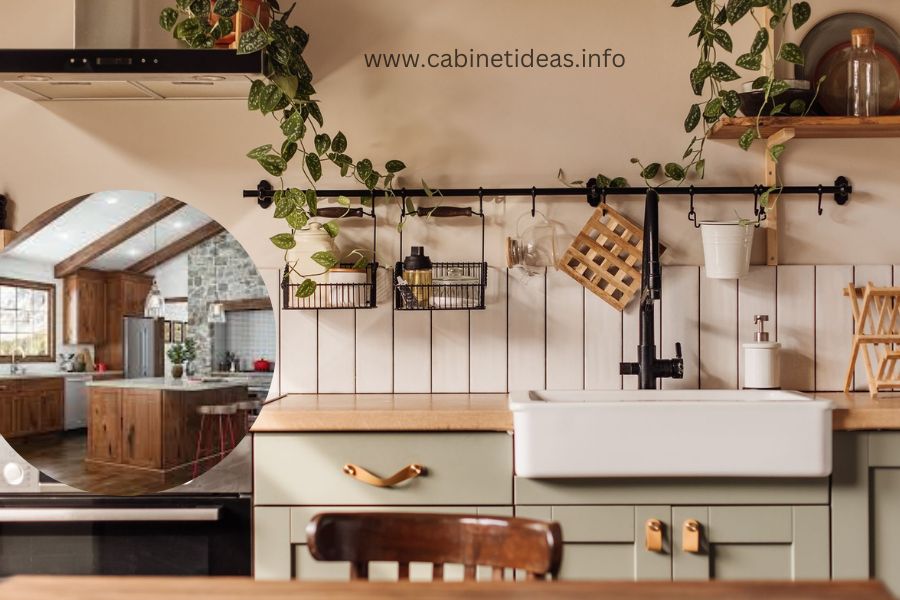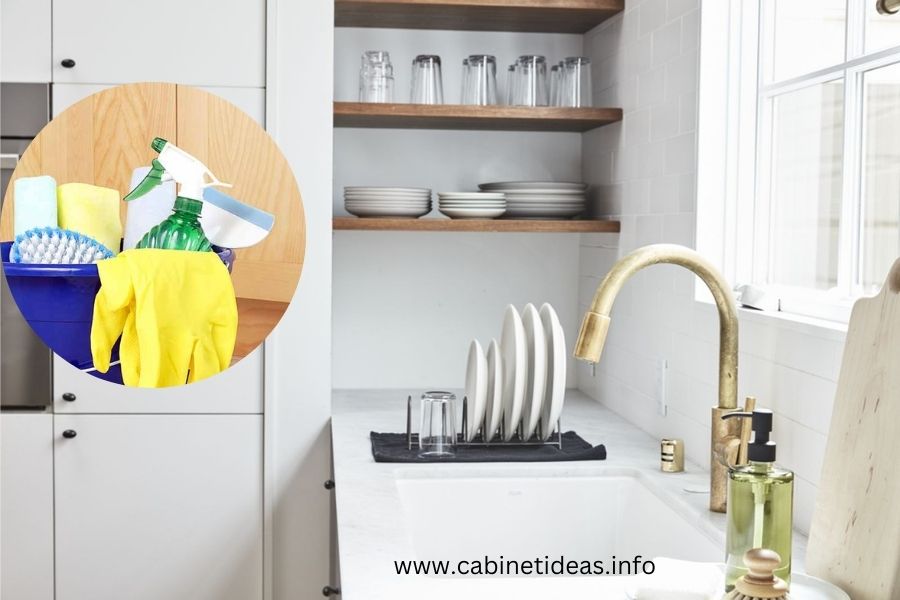How To clean greasy laminate cabinets, mix a solution of warm water and mild dish soap. Use a soft cloth to wipe the cabinets, then dry them with a clean towel.
Keeping laminate cabinets clean is essential for maintaining their appearance and extending their lifespan. Grease and grime can build up on the surface, making the cabinets look dull and dirty. By using the right cleaning techniques, you can easily remove the grease and restore the cabinets to their original luster.
We will provide a step-by-step guide on how to effectively clean greasy laminate cabinets, ensuring they remain in pristine condition for years to come. We will also discuss preventive measures to minimize the accumulation of grease and maintain the cabinets’ cleanliness.

Understanding Laminate Cabinets
Laminate cabinets are a popular choice for kitchens and other spaces due to their affordability, durability, and variety of design options. Understanding the characteristics of laminate cabinets, including their pros and cons, is essential to properly maintaining and cleaning them. In this section, we’ll explore what laminate cabinets are, the advantages and disadvantages they offer, and common issues associated with cleaning greasy laminate cabinets.
What Are Laminate Cabinets?
Laminate cabinets are constructed using a thin, decorative outer layer bonded to a core material, typically medium-density fiberboard (MDF) or particleboard. This outer layer is often made of synthetic materials such as plastic, vinyl, or laminate resin, giving laminate cabinets their versatile appearance. They are available in a wide range of colors, patterns, and textures, providing homeowners with ample design options for their living spaces.
Pros And Cons Of Laminate Cabinets
| Pros | Cons |
|
|
Common Issues With Greasy Laminate Cabinets
Greasy buildup is a prevalent issue with laminate cabinets, especially in the kitchen. Due to the cabinet’s smooth surface, grease and oil can accumulate over time, leading to unsightly stains and a sticky texture. Traditional cleaning methods may not effectively remove the grease, causing frustration for homeowners seeking a pristine and hygienic kitchen environment. Understanding how to properly tackle greasy buildup on laminate cabinets is crucial for maintaining their appearance and longevity.
Essential Tools And Supplies
When it comes to cleaning greasy laminate cabinets, having the essential tools and supplies on hand is crucial for effectively removing the built-up grime and maintaining the luster of your cabinets. From suitable cleaning agents to soft cloths and sponges, here’s what you need to tackle the task efficiently.
Cleaning Agents Suitable For Laminate Cabinets
Using the right cleaning agents is essential to prevent damage to your laminate cabinets. Opt for gentle yet effective solutions, such as:
- Dish soap solution: A mixture of mild dish soap and warm water can effectively cut through greasy residue without harming the laminate surface.
- Vinegar solution: A blend of equal parts white vinegar and water acts as a natural degreaser, making it ideal for tackling tough grease spots.
- Commercial laminate cleaner: Choose a cleaning product specifically formulated for laminate surfaces to ensure safe and thorough cleaning results.
Soft Cloths And Sponges For Effective Cleaning
When it comes to cleaning laminate cabinets, using soft, non-abrasive cloths and sponges is crucial to prevent scratching or damaging the surface. Opt for:
- Microfiber cloths: These gentle, lint-free cloths are ideal for wiping down and drying the cabinets without leaving streaks or lint behind.
- Soft sponges: Look for sponges with a gentle scrubbing side and a soft, non-abrasive side to effectively remove grease while protecting the laminate finish.
Safety Precautions To Consider
While cleaning your laminate cabinets, it’s important to prioritize safety. Consider the following precautions:
- Work in a well-ventilated area: Ensure proper air circulation to minimize exposure to cleaning fumes and maintain a comfortable working environment.
- Wear protective gloves: Shield your hands from cleaning agents and prolonged contact with water by using rubber or nitrile gloves.
- Avoid abrasive tools: Refrain from using harsh scrubbing pads or abrasive tools that can scratch or damage the laminate surface during cleaning.
Pre-cleaning Preparation
Before diving into the task of cleaning greasy laminate cabinets, it’s crucial to prepare the cabinets and the workspace properly to ensure an effective cleaning process. Pre-cleaning preparation involves removing cabinet contents, dusting and removing loose debris, and assessing the level of grease buildup. Let’s take a closer look at each step to set the stage for a successful cleaning session.

Removing Cabinet Contents
Begin the pre-cleaning process by emptying the cabinets completely. Remove all dishes, food items, and any other contents from the cabinets and place them in a safe and dry location. This step will not only make the cleaning process more manageable but also prevent the risk of damaging or staining the stored items during the cleaning.
Dusting And Removing Loose Debris
Next, use a soft microfiber cloth or a duster to remove any loose debris and dust particles from the cabinet surfaces. Wipe down the interior and exterior of the cabinets to ensure all loose dirt and debris are eliminated. This step is essential as it prepares the cabinets for the more intensive cleaning that follows while preventing the spread of dirt and grime during the cleaning process.
Assessing The Level Of Grease Buildup
After clearing the cabinets and removing loose debris, it’s important to assess the level of grease buildup on the laminate surfaces. Check for visible grease stains, sticky residues, and overall grime accumulation. Understanding the extent of the grease buildup will help determine the appropriate cleaning method and products needed to effectively tackle the grease and restore the cabinets to a clean, polished condition.
Effective Cleaning Techniques
Using Gentle, Non-abrasive Cleaners
When it comes to cleaning greasy laminate cabinets, it’s essential to use gentle, non-abrasive cleaners to avoid damaging the surface. Look for cleaning products specifically formulated for laminate surfaces. Avoid using harsh chemicals or abrasive scrubbers as they can cause scratches and dull the finish of the cabinets.
Applying The Cleaning Solution To Greasy Areas
If there are greasy spots or buildup on the laminate cabinets, apply the cleaning solution directly to these areas. Let the cleaner sit for a few minutes to loosen the grease before proceeding to the next step.
Scrubbing And Wiping Technique For Optimum Results
For optimal results, gently scrub the greasy areas using a soft sponge or microfiber cloth. Focus on circular motions to lift the grease without scratching the surface. Avoid using excessive force as it may cause damage. After scrubbing, wipe the area clean with a damp cloth to remove any residual cleaner and grease.
Maintenance And Preventive Tips
Maintenance and preventive tips are crucial for keeping laminate cabinets clean and in good condition. By implementing a regular cleaning routine, protective measures, and troubleshooting common cleaning challenges, you can effectively maintain the appearance and longevity of your cabinets.
Regular Cleaning Routine To Prevent Grease Buildup
To prevent the buildup of grease on laminate cabinets, it’s essential to establish a regular cleaning routine. Incorporating weekly dusting and wiping with a gentle cleaner is key to avoiding the accumulation of grime and grease. Consider using a mixture of mild dish soap and warm water to gently wipe down the cabinet surfaces. Avoid using abrasive cleaners that can damage the laminate finish. Additionally, wipe dry to prevent water spots and streaks from forming.
Protective Measures To Prolong Laminate Cabinet Lifespan
In addition to regular cleaning, implementing protective measures can help prolong the lifespan of laminate cabinets. Using cabinet liners can act as a barrier against spills and grease, making cleaning more manageable. When cooking, ventilate the kitchen properly to minimize airborne grease and odors from settling on the cabinet surfaces. It’s also advisable to handle oily or greasy items cautiously to prevent direct contact with the cabinet exteriors.
Troubleshooting Common Cleaning Challenges
Despite preventive measures, cleaning challenges may arise. For stubborn grease or dirt residues, consider using a non-abrasive paste of baking soda and water as a spot treatment. Apply the paste, allow it to sit for a few minutes, then gently scrub with a soft cloth. When faced with grease buildup in crevices and edges, utilizing a soft-bristle brush or toothbrush can effectively target these hard-to-reach areas. It’s important to avoid excessive scrubbing to prevent damage to the laminate finish.
Frequently Asked Questions For How To Clean Greasy Laminate Cabinets
How Can I Remove Grease From Laminate Cabinets?
To remove grease from laminate cabinets, mix warm water and dish soap, apply the solution to the greasy areas, then wipe with a damp cloth. For tougher stains, use a vinegar and water solution or a baking soda paste.
Is It Safe To Use Vinegar To Clean Laminate Cabinets?
Yes, it is safe to use vinegar to clean laminate cabinets. Mix equal parts of vinegar and water, apply the solution to the greasy areas, and wipe with a damp cloth. The acidity of vinegar helps to break down grease and grime without damaging the laminate surface.
Can I Use Commercial Cleaners On Laminate Cabinets?
Yes, you can use commercial cleaners specifically formulated for laminate surfaces. Look for cleaners that are designed to cut through grease and grime while being safe for laminate. Always follow the manufacturer’s instructions and test a small area before applying it to the entire surface.
What Should I Avoid When Cleaning Laminate Cabinets?
Avoid using abrasive cleaners, steel wool, or scrub brushes as they can scratch the laminate surface. Additionally, avoid using excessive water or allowing water to sit on the surface for extended periods, as it can cause damage to the laminate.
Always use gentle cleaning methods to preserve the finish of the cabinets.
Conclusion
Keeping your laminate cabinets clean can be easily accomplished with the right approach. By using gentle cleaning solutions, avoiding abrasive materials, and maintaining a regular cleaning routine, you can effectively remove grease and grime without causing any damage. With these simple techniques, you can enjoy beautiful, clean laminate cabinets for years to come.

1 thought on “How to Clean Greasy Laminate Cabinets : Expert Tips for Sparkling Results”